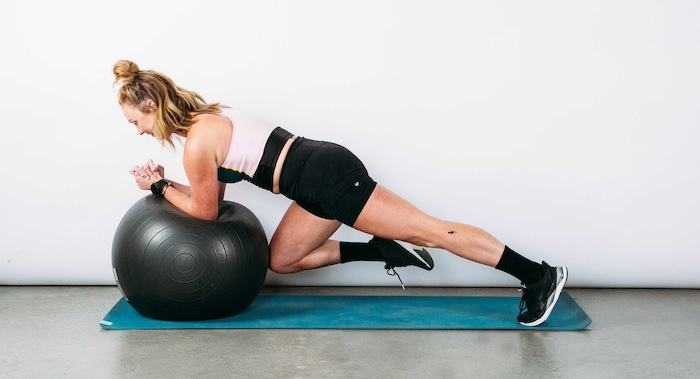
The exercise ball (or Swiss ball or physio ball) is a versatile piece of exercise equipment available to help people with back pain. In particular, many exercise ball programs are designed to bring movement to the spine in a controlled manner to help keep the discs nourished. Moving the vertebrae helps nourish the discs in the spine by increasing blood flow around the disc and by causing the water to flow in and out of the disc.
Additionally, the local gym or fitness center is often a good place to find an individual certified in exercise ball technique. In addition to being a certified individual, this website, or a video or book will be able to provide helpful information in terms of which muscles are being utilized and which muscles are necessary to achieve specific goals with the exercise ball.
The difficulty of exercises using an exercise ball will vary for each person and will challenge areas of inflexibility. Typically, a physical therapist or other spine specialist will have the patient start using an exercise ball with small, gentle movements, such as the following:
Pelvic Isolation With The Exercise Ball
- Rock back and forth - Sit on the exercise ball with arms to the sides or on your hips. Slowly do a pelvic tilt, pulling stomach muscles in and moving hips slightly toward the front to flatten the small of the back (reduce lordosis). Return to the neutral position on the exercise ball. Arch the small of the back slightly and move hips slightly toward the back. Return to the neutral position on the exercise ball. When comfortable with these movements on the exercise ball, do them continuously back and forth for 10 repetitions.
- Rock side-to-side - Sit on the exercise ball with arms to the sides or on hips. Slowly shift weight slightly to the right. Return to the neutral position. Slowly shift weight to the left. Return to the neutral position on the exercise ball. When comfortable with these movements, do them continuously side to side for 10 repetitions?
- Circles - For a more advanced exercise, start in the front/pelvic tilt position and slowly shift weight around in a circular motion, 3 times clockwise and 3 times counterclockwise.
Spine Rotation With Exercise Balls
- Sitting on the exercise ball, raise arms straight to front; without twisting at the spine, move both arms across the body to the right, bending the left elbow and keeping arms at shoulder height; move both arms to the left, bending left right elbow. Repeat 5 times to each side.
- Add head movement to the arm movement by turning the head in the opposite direction from the arm movement, still without twisting the spine. Repeat 5 times to each side.
- Increase the difficulty by spreading the feet slightly and twisting the spine toward the arm movement, straightening the opposite knee, and rocking forward slightly on the ball as necessary.
Mobility And Stretching With The Exercise Ball
- Sitting on the exercise ball with arms to sides, slowly walk feet out and lean back slightly, rolling the ball to the upper back; raise arms overhead and straighten knees to arch over the ball, moving it to the mid-spine and touching the hands to the floor. Hold stretches for 10 seconds before bending your knees, bringing your arms down, and rolling to the start position. Repeat 3 times.
- Kneel with hands on the exercise ball; use hands to roll the exercise ball out from the body, keeping back flat until hips and knees are at 90 degrees and back, head and arms are straight; roll the exercise ball slightly from side to side, 5 times on each side.
- Kneel with your chest resting on the exercise ball; roll forward and straighten your knees, with a ball at chest level, relax around the ball to stretch the upper spine.
Extension Exercises
- Lumbar extension - Place lower chest/stomach area over the exercise ball with legs straight, spread apart for stability and feet flexed up on toes (or with legs together and feet against a wall); rest hands-on side of the ball, but do not use arms to push up; slowly lift head and chest off the ball as far as is comfortable, squeezing shoulder blades while lifting; return to start position. Repeat 5 times. For a harder exercise, place hands behind the head or straighten arms above the head
- Bridge - Lay flat on the ground with legs straight. Place both legs together on the exercise ball at the calf area with arms at the sides and hands flat on the floor; tighten and lift the buttocks off the floor to straighten the back, keeping abdominal muscles tight, and hold for 5 seconds. Return to the start position. Repeat 3 to 5 times.
- Bridge with leg - make this exercise more difficult by lifting one leg at a time 1 to 2 inches off the Swiss ball.
- Bridge with arm - even more difficult, lift arms off the floor while bridging over the exercise ball.
There are hundreds of different exercises that one can do using exercise balls, or using exercise balls in conjunction with other proprioception exercises, such as the BOSU ball balance trainers, Dynadiscs, BAPS Boards, Pods, Therabands, weights, weighted balls, medicine balls, and many more. The above list describes a number of the more commonly prescribed exercises that may be used to help patients with low back pain.
Precision Pain Care and Rehabilitation has two convenient locations in Richmond Hill – Queens, and New Hyde Park – Long Island. Call the Queens office at (718) 215-1888 or (516) 419-4480 for the Long Island office to arrange an appointment with our Interventional Pain Management Specialist, Dr. Jeffrey Chacko.















